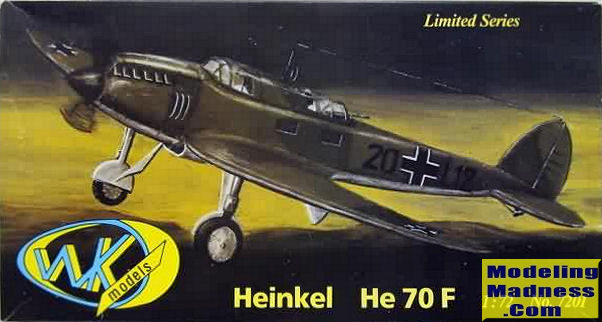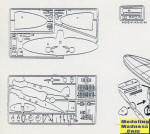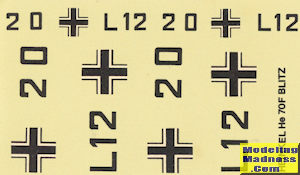
WK Models 1/72 He-70F
| KIT #: | 7201 |
| PRICE: | Raffle win |
| DECALS: | None |
| REVIEWER: | Scott Van Aken |
| NOTES: | "Made in West Germany 1987" |

| HISTORY |
The Heinkel He 70 Blitz (lightning) was designed in the early 1930s to serve as a mailplane for Deutsche Luft Hansa in response to a request for an aircraft faster than the Lockheed Vega and Orion (as used by Swissair) for use on short routes.
It was a low-wing monoplane, with the main characteristic of its design being its elliptical wing (which the Günther brothers had already used for the Bäumer Sausewind sports aircraft before they joined Heinkel) and its small, rounded control surfaces. In order to meet the demanding speed requirements, the design minimised drag, with flush rivets giving a smooth surface finish and a retractable undercarriage. It was powered by a liquid cooled BMW VI V12, cooled by ethylene glycol rather than water, allowing a smaller radiator and therefore reducing drag. The pilot and radio operator were seated in tandem, with a cabin housing four passengers on two double seats facing each other.
The first prototype flew on 1 December 1932, and proved to have excellent performance, setting eight world records for speed over distance, and reaching a maximum speed of 377 km/h (222 mph).
Twenty-eight aircraft were sent with theLegion Condor, where they were used during the Spanish Civil War as fast reconnaissance aircraft. Their high speed (and likely the already existing "blitz" title) gave them the nickname Rayo (lightning).
The He 70K (later He 170), a fast reconnaissance airplane variant, was used by the Royal Hungarian Air Force in early World War II during 1941-42. The Luftwaffe operated He 70s from 1935, initially as a light bomber and reconnaissance aircraft. As soon as purpose build designs became available, it was relegated as a liaison and courier aircraft.
The main weakness of the He 70 in military use was that crews considered it a fire risk. Elements of the airframe were made out of so-called "Elektron", though the majority of the monocoque fuselage was Duralumin. Elektron is a very light, yet strong, alloy of magnesium, which burns readily when ignited, and is difficult to extinguish. Moreover, the wings contained a non-self-sealing 47-gallon fuel tank apiece, which may have further added to the aircraft's reputation for being flammable. A single hit from a light machine gun is reputed to have often set the entire aircraft ablaze. The Hungarian He 170A (a military version derived from the He-70 with a new WM-K-14 radial engine), fleet was retired for this and other reasons, including poor defensive armament, short range and poor view from the cabin, and replaced with vintage, high-wing He 46 monoplanes, until modern Bf 109 fighter-reconnaissance and specialized Fw 189 "Uhu" medium altitude observation aircraft could be introduced.
| THE KIT |
 WK
Models is one of those companies that appears for a while, produces and kit or
two and then disappears. They produced this and an Mi-1 kit with the Mi-1 kit
being #7203. I am not positive what 7202 is or even if it ever existed, however,
this kit comes with parts not used so I suspect it was an He-170. This kit was
produced as all that was available prior to this was the Matchbox kit, at least
for injected plastic fans. There were both vac and resin kits, but they were
generally pretty basic (as is the Matchbox kit, which has been reissued by
Revell several times). It wasn't until ICM produced their much newer offering
several years back that modelers had a modern representation of this aircraft.
WK
Models is one of those companies that appears for a while, produces and kit or
two and then disappears. They produced this and an Mi-1 kit with the Mi-1 kit
being #7203. I am not positive what 7202 is or even if it ever existed, however,
this kit comes with parts not used so I suspect it was an He-170. This kit was
produced as all that was available prior to this was the Matchbox kit, at least
for injected plastic fans. There were both vac and resin kits, but they were
generally pretty basic (as is the Matchbox kit, which has been reissued by
Revell several times). It wasn't until ICM produced their much newer offering
several years back that modelers had a modern representation of this aircraft.
To be fair to WK Models, this kit was developed in the relatively early years of short run injected kits. While not as basic as Pegasus or VeeDay, the WK Models offering is still not up to modern standards. Molded in a dark green plastic with flash of various degrees on the edges and window openings; the surface of many of the parts is quite rough and will need to be sanded down. Ejector marks are large where they are extant.
The interior is not bad, but basic, consisting of a small cockpit floor/rear bulkhead with a seat, control wheel, rudder bar and instrument panel. In the back is a floor with a rear facing seat and fore/aft bulkheads. A machine gun and small mount is also included.
Wings are a full lower piece with two upper wing halves. The wheel wells are
not boxed in and the landing gear are adequate. The tail skid is molded to one
fuselage half as is the fin/rudder. Tailplanes are a single piece and butt join
to the rear of the fuselage. There are gear doors for the main gear and a short
intake piece for the oil cooler under the fuselage. The prop is molded to the
back of the spinner plate and simply butt joins to the front of the fuselage.
THere is an upper cowling piece and the exhaust pieces simply fit into the
notches for them in the fuselage side. Transparencies are a bit thick with well
defined frame lines. The plastic itself is a bit cloudy. These consist of the
individual side windows and a single upper fuselage piece that also includes the
upper fuselage. Radio and DF antennas fit atop this and the ki t comes with a
boarding ladder that apparently one props up against the wing.
t comes with a
boarding ladder that apparently one props up against the wing.
Instructions are little more than an exploded diagram showing the placement of parts. Markings are provided for the box art plane, but there is no placement or painting guide, though the instructions do list the colors needed from Xtracolor and Humbrol. The decal sheet is all one color; black. No swastika is provided as you'd expect from a kit made in Germany. I'm not sure how viable the decals might be, but they are nicely printed and might be quite useful if coated prior to use.
| CONCLUSIONS |
I am not sure how many folks would actually be interested in building this kit since the easier to build Revell/Matchbox kit is easily available as is the better detailed ICM kit. However, if one manages to get one of these via a 'deal you can't pass up' or as I did, in a raffle, then it might well be worth the effort. The sprues include the radial engine for the He-170, which should only require the removal of the BMW cowling to attach. Decals might be an issue, but any intrepid modeler should be able to put together something suitable. If you really want one, you can find them on e-paid for around $15-20.
| REFERENCES |
https://en.wikipedia.org/wiki/Heinkel_He_70
September 2016 Copyright ModelingMadness.com If you would like your product reviewed fairly and fairly quickly, please contact the editor or see other details in the
Note to
Contributors.